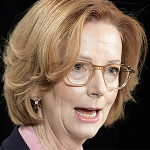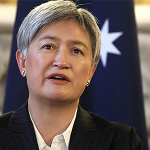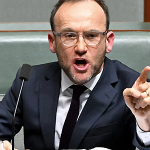
by ROGER CROOK – BRITAIN and Australia share many things. The first non-Aboriginal occupants of this country, at least in any number, were British.
We also share a common language. While the third and most important feature we share with each other is that we both live on an island; ours is much bigger than theirs, however, we have less than half their population.
- It’s nuts. Something is wrong.
- Australia’s reliance on imported food has recently increased to nearly a billion dollars a week.
- Our survival literally depends on merchant shipping and open sea routes.
During the industrial revolution, Britain for the first time in its history became a net importer of food. This was caused by the mass migration from rural areas into new factories in the rapidly growing industrial Britain.
Between 1750 and 1850 the population of Britain doubled to 18m and reached Australia’s current population forty years later.
BLOCKADE
Britain’s reliance on America and the British Empire, primarily Australia, for food continued and increased uninterrupted until 1939 when Hitler decided to blockade the Atlantic Ocean and English Channel; preventing food supplies reaching the British ports of London, Liverpool and the Clyde.
Herr Hitler’s intention was to starve the British into surrender. This act of aggression started the longest battle of the World War II, the Battle of the Atlantic (1939-45).
The German blockade failed and a dreadful price was paid for both victory and defeat; 3500 of the Allies’ merchant ships and 175 warships were sunk in the Atlantic for the loss of 783 German U-boats and 47 German surface warships, including four battleships, nine cruisers, seven raiders, and 27 destroyers.
Sixty thousand sailors died; thirty thousand on each side perished in the cold Atlantic waters. A terrible toll was paid for a reliance on America and the Empire for food and arms and eventually victory.
There are disturbing similarities between Britain in 1939 and Australia in 2024.
Some things never change; we are still both islands and our survival continues to depend on merchant shipping.
In 1939 Australia was self-sufficient in food, feeding seven million people.
Making up just over 30 per cent of the population, those in our rural areas were exporting high quality meat, dairy products and fruit. Australia’s main industry was agriculture.
Almost 60 per cent of the food Australia exported went to Britain and 69.5 per cent of all exports went to what were British possessions, including Canada, Ceylon, Fiji, Hong Kong, India, Malaya, Singapore, Mauritius, New Zealand, Papua and the Union of South Africa.
From the very beginning, as a vital ingredient of the industrial revolution, wool from about 100 million Australian merino sheep went to British mills.
In 1939 Australia rode on the sheep’s back and on the sweat of its farmers.
Eighty year later nothing much has changed for Britain, in fact their dependence on food imports has increased. Sadly, their wool processing industry is a mere shell of what it was; China is now in control.
In Australia a lot has changed; we now find ourselves in almost the same position as Britain in 1939 or worse, and there isn’t a war – not yet.
NO HELP
What should be of concern to Australia in 2024 is that, unlike Britain in 1939, America is not 14 days away with an unlimited supply of food and armaments. We are on our own in this one; we have no close neighbours who can help.
There is practically nothing that we eat that cannot be grown and if necessary, processed in Australia.
Our diversity of the climate from the tropical north to the temperate south and everything in between makes us one of the most fortunate countries in the world.
We should be able enjoy the knowledge that we need not rely on any other country for any of our food, nothing.
We should be able to celebrate that we can export our surplus to help feed a hungry world like we once did. Sadly, that is no longer the case.
Australia’s reliance on imported food is increasing; currently it represents about 12 per of all the food we eat; in 2021-22 food imports grew by 15 per cent on the previous year to reach $24.3b import value, about $48b retail; households spend nearly a billion a week on imported food.
The claims that Australia grows enough food to feed seventy million, so there will never be a food shortage in Australia is grossly misleading and gives this country a false sense of security.
Australia may well produce sufficient calories to feed seventy million, but those calories are, mainly, in “unimproved” foods like bulk cereals, oil seeds, live animal exports and boxed meat.
We also export unimproved, boxed or packaged fruit and vegetables to the value of $2.75b annually.
New Zealand, America, the EU including the UK and surprisingly Singapore, are our main food suppliers.
These four advanced economies sell food to us worth more than $13b a year (more than 50 per cent of all food imports) and the value is increasing year on year.
Virtually all the food we import has had value added to it. It has been bottled, tinned, frozen or processed in some way.
BULGARIA
Australia grows the best peaches in the world, yet we import them, bottled, from Bulgaria on the other side of the world.
Frozen vegetables from New Zealand, some sourced in China, are repackaged and exported to us under our Free Trade Agreement with the Kiwis.
Australia grows some of the best Durum (pasta) wheat in the world; we import pasta worth $90m from Italy giving them a 20 per cent market share.
Italy has a 71 per cent share of the canned tomato market in this country worth $171m annually and growing.
Somewhere in Australia tomatoes can be grown 12 months of the year, yet the cost of growing and processing in this country is uncompetitive, so this market has gone to our Italian friends. Grazie mille! Prego.
Fish, 70 per cent of what we eat is imported, yet we are an island nation surrounded by vast oceans which others fish. The bulk of the fish we import is from New Zealand and all there is between them and us, is water, with fish in it.
More than 90 per cent of bacon and other processed pork is imported mainly from the EU.
That we rely on imports for our traditional bacon and eggs breakfast is worth contemplating.
How is it that those who export food to us can produce, package and transport, in some cases 16,000km by sea from the EU and America and still make a profit; when Australians can’t, figuratively, get pigs from Toowoomba to Brisbane, make them into bacon, get them into the shops and also make a profit?
It’s nuts. Something is wrong.
The overwhelming majority of the food we import arrives by sea, mainly to the eastern seaboard via the Tasman Sea, the Pacific Ocean, the Coral Sea and the Indian Ocean via the Red Sea and the Suez Canal. This is a vast expanse of ocean on which we depend and cannot defend.
If any of those routes are closed, the prices we pay for our food will increase; it’s called inflation.
In spite of shrill government propaganda from Minister Chris Bowen for a zero carbon economy, Australia is still totally dependent on oil.
We are a trucking nation. Our food production and distribution depends on diesel oil and the trucks that use it.
SPITE
In spite of occasional publicity and expressions of concern, we still only have about 30 days supply of oil products – petrol, diesel and aviation fuel – in this country at any one time. That supply includes the needs of the ADF.
All the oil products we use come by sea, with more than 90 per cent as refined product. They all originate in either countries or regions of unpredictable levels of political tension.
Our oil leaves one country by sea, goes to another to be refined and then arrives in Australia, again by sea. Our oil could have travelled the Straits of Hormuz, the Gulf, the South China Sea or the Malacca Straits, sometimes twice.
Without oil for a few weeks this country will be forced to slow down; without oil for a few months, it will stop. Food will stay on the wharf and in the paddock. The trucks will be idle.
It is over three months since Hamas invaded Israel and the children in Gaza have been going hungry for many weeks; how time flies.
I quite often contemplate why we don’t have any oil reserves in this country and at the same time I wonder why I pay taxes so that the government can give those on $200,000 a year a childcare subsidy?
There’s no limit to what a government will pay to remain in power.
What kind of person with that kind of income claims that kind of subsidy from someone like me?
I don’t understand why we are spending billions on wind and solar and a net-zero economy when we can’t defend our country and protect the seas that surround us, seas on which we depend for our survival.
I’ve started wondering whether Karl Marx was right after all: “History repeats itself, first as tragedy, second as farce.”
Did the tragedy happen and we didn’t notice? Because it’s a farce now.PC













Actually about 7 days liquid fuel onshore. The rest of the “onshore” is in tankers on the way here.
Look again at the United Nations Lima Agreement 1975 signed by Whitlam Labor agreeing to allow the exit from Australia of manufacturing industry businesses to UN rated “developing nations”, like China.
Next look at the United Nations Agenda 21 (now 2030) – Sustainability – and the numerous impositions covered including red, green and black tape government regulations and compliance costs for businesses.
Followed by the climate change warming trend modelling hoax (as compared to natural climate zone changes over time, and weather conditions, part of Earth Cycles since time began) and the UN IPCC Kyoto Japan Climate Conference and Agreement with emissions reduction target for signatory nations. And what followed.
Included in the closures were the several oil refineries here, now only two or three left operating.
Also consider the abundance of fossil fuels reserves Australia has – natural gas & oil, shale oil, high grade black coal, lower grades of coal including lignite brown coal used in power stations in Victoria, uranium, thorium and salt (thorium molten salt reactor fuels).
There are capped oil and gas wells dotted around Australia, several for example drilled in the early 1900s around the Roma District of Queensland and capped because Middle East oil was less expensive to extract and ship to markets. Australia’s known reserves well exceed what the government and many politicians are prepared to admit. In Gippsland Victoria natural gas reserves are estimated to exceed the bass Strait reserves before extraction commenced. Below Cooper Pedy SA some distance from the Momba gas fields is another huge gas/oil field, just north of Woomera.
We are being robbed people.
Our common wealth, most of it, is locked away and the United Nations are a major influencing factor.
The Coalition did buy a substantial amount of oil from the US and our oil is stored in US facilities underground, but our oil refinery capacity is tiny.
No problem, potential enemy nuclear submarines would not be lurking around shipping lanes would they.
sarc